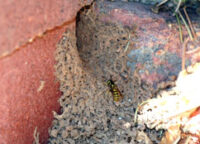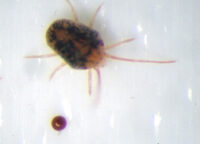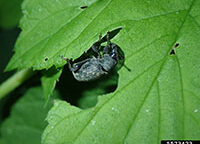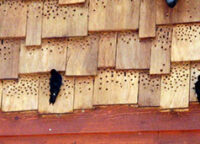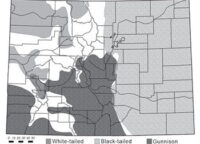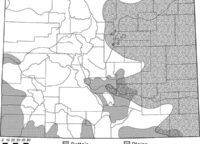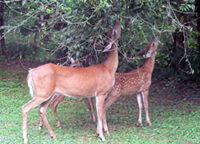Brownheaded Ash Sawfly – 5.586
Print this fact sheet by W.S. Cranshaw* (7/14) Quick Facts… The green, worm-like larvae chew the leaves of ash trees in spring. Weather is the most important natural control. Late spring frosts and strong winds may kill large numbers. During the early stages of an infestation, larvae make small “pinhole” wounds in the interior of […]
Take a Tour- 08, 10, 2015
- No Comments.
- By
Nuisance Wasps and Bees – 5.525
Print this fact sheet by W.S. Cranshaw* (12/12) Quick Facts… Most wasps develop by feeding on insects. Bees develop on a diet of nectar or pollen. Almost all insect stings result from yellowjackets and an insect newly established in the state, the European paper wasp. Yellowjackets, hornets and paper wasps make nests of paper. Honey […]
Take a Tour- 08, 10, 2015
- No Comments.
- By
Clover and Other Mites of Turfgrass – 5.505
Print this fact sheet by W.S. Cranshaw* (6/13) Quick Facts… Several species of spider mites can damage turfgrass in Colorado: clover mite, Banks grass mite and brown wheat mite. Most damage occurs during early to midspring. Damage to turfgrass is primarily related to dry conditions and turfgrass stressed by drought. Clover mites can be a […]
Take a Tour- 08, 10, 2015
- No Comments.
- By admin
Root Weevils – 5.551
Print this fact sheet by W.S. Cranshaw* (1/19) Quick Facts… Root weevils can be common insects that develop on roots of many garden plants. Adult root weevils chew distinctive notches along the edges of leaves at night. Some kinds of root weevils often wander into homes but cause no injury indoors. Insecticides applied on the […]
Take a Tour- 08, 06, 2015
- No Comments.
- By admin
Preventing Woodpecker Damage – 6.516
Print this fact sheet by W.F. Andelt, S.N. Hopper and M. Cerato* (8/14) Revised by M. Reynolds** Quick Facts… The northern flicker, responsible for most woodpecker damage to Colorado homes, is identified in flight by a yellow or salmon tint under the wings and tail feathers. Woodpeckers cause property damage by drilling holes in wood […]
Take a Tour- 08, 06, 2015
- No Comments.
- By admin
Managing Voles in Colorado – 6.507
Print this fact sheet by W.F. Andelt, S. Ahmed and K. Jones* (11/15) Quick Facts… Eight species of voles are found in Colorado. They often are called meadow, field or pine mice. Voles are small mammals that cause damage by girdling seedling and mature trees in orchards, shelterbelts and forests. They also damage field crops […]
Take a Tour- 08, 06, 2015
- No Comments.
- By admin
Managing Prairie Dogs – 6.506
Print this fact sheet by W.F. Andelt, S.N. Hopper* (3/16) Quick Facts… Three species of prairie dogs occur in Colorado. Prairie dogs and their burrows serve as important hosts for numerous other animals. Prairie dogs can damage rangeland and occasionally harbor plague. Control problem prairie dogs by relocation, visual barriers, shooting, poison grain bait, and […]
Take a Tour- 08, 06, 2015
- No Comments.
- By admin
Managing Pocket Gophers – 6.515
Print this fact sheet by W.F. Andelt and R.M. Case*(2/16) Quick Facts… Four species of pocket gophers are found in Colorado. Pocket gophers reduce productivity of portions of alfalfa fields and native grasslands by 20 to 50 percent. Damage by pocket gophers can be reduced by exclusion, cultural methods and habitat modification, trapping, and toxicants […]
Take a Tour- 08, 06, 2015
- No Comments.
- By admin
Farming and Pheasants in Colorado – 6.512
Print this fact sheet by D.E. Benson 1 (9/09) Quick Facts… Decline in pheasant numbers occurs at the same time that farming intensifies. Agriculture and pheasants can thrive simultaneously. Pheasants can become part of farming profits. Some agricultural practices benefit pheasants and farmers. Some agricultural practices benefit pheasants at the cost of farm profits. Some […]
Take a Tour- 08, 06, 2015
- No Comments.
- By admin
Preventing Deer Damage – 6.520
Print this fact sheet by C.E. Swift and M.K. Gross (12/01)* Revised by Kurt Jones (10/14)**, revised by John Murgel (2/21)*** Quick Facts… It is difficult to move deer out of areas where they are not wanted. A hungry deer will find almost any plant palatable, so no plant is “deer proof.” The two types […]
Take a Tour

